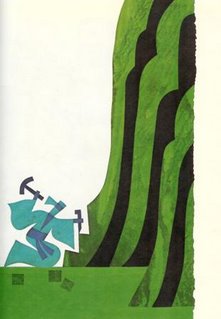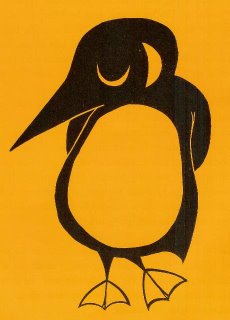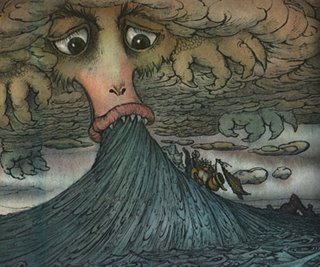
Sunday, December 09, 2007
Who Is Aliki?

Thursday, November 29, 2007
A Wrinkle in Time: Rejected 27 Times!

This is the image on the cover of the edition I read as a child. By the way, if you haven't read this book. . . get on it. Possibly the most seminal work of fiction responsible for shaping my young mind. (Runner up: The Lion, the Witch and the Wardrobe)
Tuesday, October 02, 2007
Essential Reading List
Picture Books (0-8 ish)--Mercer Mayer (One Monster After Another or Liza Lou and the Yellerbelly Swamp), Maurice Sendak (Where the Wild Things Are), Margaret Wise Brown (Good Night, Moon), Shel Silverstein (The Giving Tree), Dr. Seuss (Any).
Early Reader (5-9 ish)--Arnold Lobel (Frog and Toad books), AA Milne (Winnie the Pooh books), Jean de Brunhoff (Babar books), Antoine de Saint-Exupery (the Little Prince), Judy Blume (Tales of a Fourth Grade Nothing), Louise Fitzhugh (Harriet the Spy), EL Konigsburg (From the Mixed-Up Files of Basil E. Frankweiler).
Middle Grade (middle schoolers)--Ellen Raskin (The Westing Game and The Tattooed Potato), Lois Lowry (The Giver), Madeliene L'Engle (A Wrinkle in Time), Jeanne DuPrau (City of Ember), Ursula K. LeGuinn (The Earthsea Trilogy and The Beginning Place), CS Lewis (The Chronicles of Narnia).
Young Adult (high schoolers)--JD Salinger (Catcher in the Rye), Ellen Hopkins (Crank), MT Anderson (Feed)
Then, you also have the classics in children's lit, which don't fall so neatly into the categories: Charlotte's Web, Treasure Island, Huckleberry Finn/Tom Sawyer, Little Women, Heidi, The Wind in the Willows, Alice in Wonderland/Through the Looking Glass, The Wizard of Oz, anything by Roald Dahl, Jack London, Rudyard Kipling, Beatrix Potter, Dr. Seuss, and of course, JK Rowling and Lemony Snicket. Some might also say Hawthorne and Cooper and Tolkein might be considered in this category.
Books I haven't read, but are classics: Bud, Not Buddy; The Phantom Toll Booth, Walk Two Moons, A Tree Grows in Brooklyn, Uncle Tom's Cabin, To Kill a Mockingbird, I Know Where the Red Fern Grows. Some new classics I haven't read: Luis Sachar (Holes), the Alex Rider series.
Friday, July 06, 2007
Jozef Wilkon
 This information comes courtesy of http://www.childscapes.com/, (another site worth visiting if you are interested in learning more about children's book illustrators.
This information comes courtesy of http://www.childscapes.com/, (another site worth visiting if you are interested in learning more about children's book illustrators.
 Wilkon cooperates with number of publishers in Poland and abroad. He has illustrated over 100 books for children and for adults in Poland."
Wilkon cooperates with number of publishers in Poland and abroad. He has illustrated over 100 books for children and for adults in Poland."Okay, back to my thoughts again: One of the things I have been struggling with as I learn to illustrate is what medium I will work in. I've been struggling over the froggy painting now for so long because I really don't have the mastery of the medium (acrylic paints). My drawing is probably more practiced and natural. But what I see in Wilkon that makes him so interesting to me is his ability to illustrate beautifully in so many different media. As an artist, I think this must be the most creatively fulfilling way to work. As a business person, I see how this could make it difficult to develop a recognized style--or brand--that makes it possible for publishers to market your work. Clearly, Wilkon is an artist, not a brand.
Thursday, June 28, 2007
Affinities and Special Finds
As you can see, both rely on a limited color palatte that very clearly marks them as 70s-era books. Papa Night (above) is written by Ruth A. Sonneborn and illustrated by Emily A. McCully. The story follows a loving but poor family whose papa has to work two jobs. As a result, he only spends one night a week, Friday night, with his family. Sad, but expectedly somber for the 70s. (published by Viking in 1970)
Potato Pancakes, written and illustrated by Marilyn Hirsh, is a Hannukkah tale published by the Jewish Publication Society of America in 1978. I love how these two books, about two drastically different cultural experiences (one Latino, the other Jewish, one urban and modern, the other folkloric), are linked together by their two-toned illustration, which clearly identifies the books as being of the same era.
Special Finds
When I'm bookhunting, I'm looking for books I recognize or for books whose illustrations are so beautiful and unique that they belong in my collection--my special finds. Yesterday, I came across two new illustrators in the special finds category: Jozef Wilkon and Robert Andrew Parker.

The Story of the Kind Wolf (above), written by Peter Nickl and Illustrated by Jozef Wilkon, features heart-renderingly sweet chalk pastel drawings of a wolf who plays against type. (North-South Books; 1982).
The second find, The Trees Stand Shining, features the poetry of the North American Indians selected by Hettie Jones, and the Paintings of Robert Andrew Parker. I particularly love this little cricket.

Monday, May 07, 2007
My Idol, Ellen Raskin
 Ellen Raskin, Author and Illustrator
Ellen Raskin, Author and IllustratorOne of the fun things about pursuing an interest is that you begin to see affinities that you weren't previously aware of. Case in point: My favorite book growing up was The Westing Game (okay, sometimes I might say it was the Beginning Place, but it depended on the day) by Ellen Raskin. For those of you who have never read it, get it. Get it now. It holds up on every level, for kids and adults. This book is what the industry would probably call a "young reader or young adult" novel meaning it is for middle-school age kids or thereabouts. I have read it at least 5 times in my life, twice or more as an adult. I also went on to read her other novels, including The Tattooed Potato and Other Clues, The Mysterious Disappearance of Leon (I Mean Noel), and Figgs and Phantoms.

Now, rewind to 1974, when one of my earliest memories occurs: my parents reading me Moose, Goose and Little Nobody (illustration above), a Parents' Magazine Press book. The illustrations remained imprinted on my brain until my thirties, when I began re-collecting all the old books from my childhood in anticipation of sharing them with my own child. One of the first books I tried to find and buy was Moose, Goose and Little Nobody. When it finally arrived through the mail, I opened the envelope to discover it was written and illustrated by, you guessed it, Ellen Raskin. To that point, I had had no inkling that the novelist I'd admired was also one of the illustrators I had most loved as a child. Since then, I've been trying to acquire all of her other works as well. (Cover art for Who, Said Sue, Said Whoo?, another children's picture book, below.)

One of the things I like about her illustrations is the bold use of color. She doesn't settle for boring old primary colors, either. She doesn't worry about realistic shading, either. Plus, I like her flat perspective and pen and ink outlines. (Hmm, am I sounding like a broken record here?)
Thursday, April 12, 2007
Minimalist illustration from the 60s and 70s
 One of the things I look for when I'm hunting for books is a distinctive illustrative style. Many of the Parents Magazine Press books feature a bold, mimimal style that uses a lot of line drawings. Here, I want to show off some illustrations from books I just listed. First, Attic of the Wind by Doris Herold Lund and illustrated by Ati Forberg, is a stunning combination of cloudy background with brilliant foreground.
One of the things I look for when I'm hunting for books is a distinctive illustrative style. Many of the Parents Magazine Press books feature a bold, mimimal style that uses a lot of line drawings. Here, I want to show off some illustrations from books I just listed. First, Attic of the Wind by Doris Herold Lund and illustrated by Ati Forberg, is a stunning combination of cloudy background with brilliant foreground. Next, The Stonecutter, though not a book I read as a child, seemed to fit perfectly among my collection, because of its bold, block-style prints.
Next, The Stonecutter, though not a book I read as a child, seemed to fit perfectly among my collection, because of its bold, block-style prints. Finally, I found this very obscure book, The Bed that Went Whoosh to Moyle, neglected on the back shelves of a used book store. I knew I had to expose its quirky graphics to the world.
Finally, I found this very obscure book, The Bed that Went Whoosh to Moyle, neglected on the back shelves of a used book store. I knew I had to expose its quirky graphics to the world.
Upstairs, the penguin, was sad.


